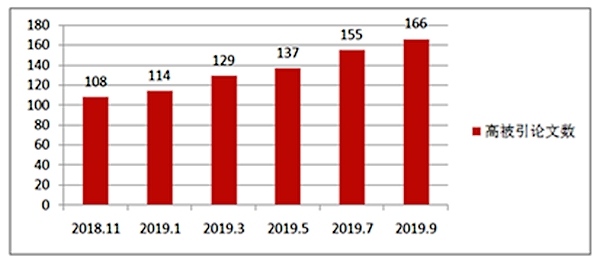
 Home»
News
Home»
News
According to the latest data released by ESI (Essential Science Indicators), as of September 12th, 2019, our university ranked 899th in the global scientific research institutions (the total number of institutions on the global list is 6081), which is 11 times higher than that in July, ranking 54th in the domestic scientific research institutions. Since September 2018, the ESI ranking of NWAFU has been rising steadily, from 1025 to 899, a total of 126 places (Figure 1).

Figure 1: NWAFU’s ESI comprehensive ranking has increased steadily (Nov.2018-Sept.2019)
At the same time, the number of highly cited papers in our university has reached 166, achieving a 12-month continuous growth (Figure 2), with 4 hot papers. The number of highly cited papers increased by 58 compared with the same period in 2018, a year-on-year increase of 53.7%. Hot papers increased by one article over the same period of 2018, an increase of 33.3% year-on-year, both hitting record highs.

Figure 2: The number of highly cited papers in NWAFU continues to grow (Nov.2018-Sept.2019)
Our university still ranks in the top 1% of the world in seven disciplines, namely agricultural science, plant and animal science, engineering, environmental science and ecology, chemistry, biology and biochemistry, pharmacology and toxicology, of which agricultural science is 1‰in the world. Agricultural science ranked 22, plant and animal science ranked 129, engineering ranked 766, environmental science and ecology ranked 372, chemistry ranked 860, biology and biochemistry ranked 598, pharmacology and toxicology ranked 813. The agricultural sciences ranked the same as the previous period, with a slight increase in the rankings of plant and animal sciences, environmental sciences and ecology, chemistry, pharmacology and toxicology, and a slight decline in engineering, biology and biochemistry.
SSCI articles publication has made great progress(Figure 3). Up to now, 100 articles have been included, which has exceeded 28.2% of the total publications in 2018, an increase of 85.2% over the same period last September, and an increase of 31.6% over the previous period. Among them, the number of papers with NWAFU as the first signature unit is 76, which is 111.1% higher than that in 2018 and 38.2% higher than that in the previous period; the number of papers with NWAFU as signature unit of the first author is 79, which is 132.4% higher than that in 2018 and 33.9% higher than that in the previous period.

Figure 3: The growth of SSCI articles in NWAFU is remarkable.
2045 SCI articles have been published, an increase of 15.3% over the same period in 2018 and 31.8% over the previous period. Among them, 1546 papers were signed NWAFU the first unit, accounting for 75.6% of the total, increased by 12.7% over the same period in 2018 and 32.5% over the previous period; 1552 papers were signed NWAFU the first corresponding author, accounting for 75.9% of the total, increased by 13.9% over the same period in 2018 and 30.8% over the previous period.
Translated by: Ruan Shuling
Proofread by: Zhang Xiaorong